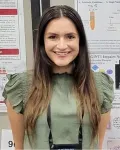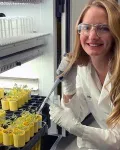(Press-News.org) For millions of years, underground fungi have lived in symbiosis with plant roots. Plants provide photosynthesized carbon, while fungi deliver water and nutrients. In order to do so, these organisms share space at cellular scale: fungi stretch a network of tendrils called arbuscules into a plant’s root cells, and both organisms rearrange their cells around this structure to facilitate sharing.
Recently, researchers have been able to study both sides of this interaction up close, using RNA sequencing to understand gene expression: one of the first cross-kingdom spatially-resolved transcriptomics studies to date. This paper is the cover article for the April 2024 issue of Nature Plants.
“We wanted to better understand the nature of this symbiosis at the cellular level — really understand how those two cell types [of two different organisms] are interacting with each other, without all the noise or other biological activity of the surrounding neighborhood,” said Benjamin Cole, senior author of this work. Cole is a research scientist at the U.S. Department of Energy (DOE) Joint Genome Institute (JGI), a DOE Office of Science User Facility located at Lawrence Berkeley National Laboratory (Berkeley Lab).
Specific understanding of this symbiosis could offer improvements in multiple directions. On the fungi side, underground mycorrhizal networks can serve as a reservoir for carbon compounds that plants generate from carbon dioxide they take in. In this way, encouraging this symbiosis could improve the way soils store carbon from the atmosphere. For plants, boosting this relationship could improve biofuel feedstocks growing in nutrient-poor fields. “This is one interaction that allows plants to better survive in those environments,” Karen Serrano said. She is first author of this paper and a graduate researcher at the Joint BioEnergy Institute (JBEI).
Cole led the work in collaboration with JBEI as part of the 2021 Laboratory Directed Research and Development (LDRD) program. Cole also received a DOE Early Career Research Program (ECRP) award in 2021, which aims in part to build off of this work. Former JGI postdoctoral scholar Margot Bezrutczyk collaborated extensively with Cole and Serrano to collect and analyze the single nuclei and spatial transcriptomics data this work leverages.
These experiments focused on two species at once: the model legume species Medicago truncatula and the mycorrhizal fungi Rhizophagus irregularis. To see how these organisms cooperate, this team applied R. irregularis spores directly to M. truncatula seedlings grown in a controlled environment chamber, so the fungus could colonize the plants’ roots. Then, comparing with control seedlings which were not treated with fungi, they used multiple approaches to look at gene expression in both plant cells and fungal cells.
Using a technique called single nuclei RNA sequencing, the researchers identified different cell types within M. truncatula root cells, and profiled their gene expression. Then, the researchers used a technique called spatial transcriptomics, to generate maps of gene expression. This spatial transcriptomics technique allowed them to understand gene expression within circular capture areas roughly 55-microns in diameter — about the width of a human hair. At such resolution, this spatial transcriptomics data captured molecular information from both plant cells and fungal cells.
“Because this technology relies on just polyadenylated transcript capture — any RNA that is from eukaryotes — we were able to capture both plant and fungal transcripts,” Serrano said. This team quantified the expression of over 12,000 fungal genes, in addition to associated plant genes.
All together, these data offer a granular view of both plant and fungal activity at different stages of this symbiosis. Within that activity, Serrano, Cole and their team found over 1,000 upregulated genes, 188 of which were shared with previous studies in the same system. With the right functional characterization, those genes could become dials for tuning this symbiosis. “Those are great candidates for genetic engineering. Our hope is that the community at large will follow that up,” Serrano said.
This work focused on a relatively well-understood model system, so future directions will also include targeting biofuel feedstocks in similar studies. “We would like to look at arbuscular mycorrhizal symbiosis in other bioenergy grasses, like sorghum and switchgrass. We're optimizing systems now, so that we can get those working,” Cole said.
###
The U.S. Department of Energy Joint Genome Institute, a DOE Office of Science User Facility at Lawrence Berkeley National Laboratory, is committed to advancing genomics in support of DOE missions related to clean energy generation and environmental characterization and cleanup. JGI provides integrated high-throughput sequencing and computational analysis that enable systems-based scientific approaches to these challenges. Follow @jgi on Twitter.
DOE’s Office of Science is the largest supporter of basic research in the physical sciences in the United States, and is working to address some of the most pressing challenges of our time. For more information, please visit science.energy.gov.
The Joint BioEnergy Institute is a DOE Bioenergy Research Center managed by Berkeley Lab. For more information, please visit jbei.org.
END
Donations for a political candidate can be motivated by support for that candidate or by opposition to the candidate’s opponent. New research published in Social Science Quarterly found that female Democrats and non-white male Democrats in the United States have a fundraising advantage when running against a white male Republican. Female Republicans or non-white male Republicans do not have this advantage when running against white male Democrats.
To assess the impact that race, gender, and party ...
Berlin, Germany – 8 April 2024: The first randomised trial to investigate preventive ablation of a potential arrhythmogenic substrate associated with coronary chronic total occlusion (CTO) in patients at high risk of ventricular arrhythmias (VAs) reduces the risk of appropriate implantable cardioverter-defibrillator (ICD) therapy and unplanned hospitalisation in patients with no previously recorded VAs. The late-breaking science is presented at EHRA 2024, a scientific congress of the European ...
PLYMOUTH MEETING, PA [April 8, 2024] — The National Comprehensive Cancer Network® (NCCN®)—a nonprofit devoted to patient care, research, and education—is announcing the election of Matt Kalaycio, MD, FACP, as Chair of the Board of Directors, with Christopher H. Lieu, MD, elected as Vice-Chair, succeeding Dr. Kalaycio in the position he has held since 2022.
“The exemplary leadership from our board of directors is invaluable as NCCN defines and advances high-quality, high-value, patient-centered cancer care around the world,” said NCCN Chief Executive Officer Crystal S. Denlinger, ...
A new study presented at the European Psychiatric Association Congress 2024 reveals a significant rise in mental health issues among children and adolescents displaced by the war in Ukraine. The research, conducted by the Institute of Forensic Psychiatry of MoH of Ukraine, highlights the devastating impact of prolonged exposure to violence and displacement on the mental well-being of young people.
As per UNICEF’s recent report on “The State of the World’s Children 2021”, the current COVID-pandemic ...
Researchers at McGill University have come up with an innovative approach to improve the energy efficiency of carbon conversion, using waste material from pulp and paper production. The technique they’ve pioneered using the Canadian Light Source at the University of Saskatchewan not only reduces the energy required to convert carbon into useful products, but also reduces overall waste in the environment.
“We are one of the first groups to combine biomass recycling or utilization with CO2 capture,” said Ali ...
Berlin, Germany – 8 April 2024: A new technology using ultralow temperature cryoablation (ULTC) has eliminated clinical ventricular tachycardia (VT) in 94% of patients. The late-breaking science is presented at EHRA 2024, a scientific congress of the European Society of Cardiology (ESC).1
VT is a leading cause of sudden death in patients with heart failure and a reduced ejection fraction.2 Approximately 30% of patients with ischaemic and non-ischaemic cardiomyopathies develop ventricular arrhythmias including VT.3 Typical therapies to prevent VT include antiarrhythmic medication, such as amiodarone, and an implantable ...
Researchers with McMaster University have crafted the first-ever guidelines to help prepare families who plan to build their child’s tolerance to common food allergens.
These international guidelines, published on April 8, 2024 in the Journal of Allergy and Clinical Immunology, standardize the preparation process for families considering oral immunotherapy, a process that involves giving very small amounts of an allergen, like peanuts, to patients and gradually increasing the amount to build up their tolerance.
Until now, ...
Berlin, Germany – 8 April 2024: An international consensus statement on how to treat atrial fibrillation with catheter or surgical ablation is published today in EP Europace,1 a journal of the European Society of Cardiology (ESC), and presented at EHRA 2024, a scientific congress of the ESC.2
Lead author Dr. Stylianos Tzeis said: “Ablation is the most effective way to prevent recurrences of atrial fibrillation and delay progression to more advanced forms. Pioneering techniques have emerged since the previous consensus in 2017,3 requiring new advice on who should receive this procedure and how to perform it in the safest and most effective manner.”
Atrial ...
A 10-minute virtual reality (VR) session significantly lessened pain in hospitalized patients with cancer in a recent clinical trial published by Wiley online in CANCER, a peer-reviewed journal of the American Cancer Society. Even a day later, participants experienced sustained benefits.
Most people with cancer experience pain, and treatment usually involves medications including opioids. VR sessions that immerse the user in new environments have been shown to be a noninvasive and nonpharmacologic way to lessen pain in different patient populations, but data are lacking in individuals ...
A new study presented at the European Psychiatric Association Congress 2024 reveals a significant association between prenatal cannabis use disorder (CUD) and an increased risk of neurodevelopmental disorders in offspring, including attention deficit hyperactivity disorder (ADHD), autism spectrum disorder (ASD), and intellectual disability (ID).
Cannabis remains by far the most consumed illicit drug in Europe. Around 1.3% of adults in the European Union (3.7 million people) are estimated to be ...



